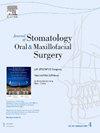Systemic sequelae and craniofacial development in survivors of pediatric rhabdomyosarcoma
IF 1.8
3区 医学
Q2 DENTISTRY, ORAL SURGERY & MEDICINE
Journal of Stomatology Oral and Maxillofacial Surgery
Pub Date : 2025-02-01
DOI:10.1016/j.jormas.2024.102024
引用次数: 0
Abstract
Introduction
The aim of this study was to evaluate the systemic sequelae, as well as the dental and craniofacial development, of patients with rhabdomyosarcoma in relation to the treatment received and clinical-pathological variables.
Materials and Methods
A retrospective cross-sectional study was performed. All individuals diagnosed with RMS between 1990 and 2022 were considered eligible. Cases who survived the primary tumor were included. Data were collected from medical records, and patients were called for clinical and radiographic examinations.
Results
Thirty-eight patients were assessed, with a mean disease-free survival of 216.68 months (±84.99). The primary location of the tumor was mainly the head and neck region (57.9 %). All patients received chemotherapy, and 30 (78.9 %) also underwent radiotherapy. The most frequently observed sequela was sensory impairment, which was significantly associated with tumors in the head and neck (p < 0.05), as well as with the use of radiotherapy (p = 0.034). Root formation failure was observed in 60 % of cases, microdontia in 50 %, and delayed tooth eruption in 40 %. A convex profile was predominant (80 %), along with maxillary (50 %) and mandibular (80 %) retrusion and a skeletal class II diagnosis (60 %).
Conclusions
Late systemic, dental, and craniofacial developmental sequelae are observed in pediatric rhabdomyosarcoma survivors, especially in patients who underwent radiotherapy in the head and neck region. Younger individuals at the time of treatment are at greater risk of late sequelae.
小儿横纹肌肉瘤幸存者的全身后遗症和颅面发育。
简介本研究旨在评估横纹肌肉瘤患者的全身后遗症以及牙齿和颅面发育情况与所接受的治疗和临床病理学变量的关系:进行了一项回顾性横断面研究。所有在 1990 年至 2022 年期间确诊的横纹肌肉瘤患者均符合条件。研究纳入了至少有5年无病生存期(DFS)的病例。研究人员从病历中收集数据,并召集患者进行临床和放射学检查:共评估了 38 例患者,平均无病生存期为 216.68 个月(±84.99)个月。肿瘤的原发部位主要是头颈部(57.9%)。所有患者都接受了化疗,其中30人(78.9%)还接受了放疗。最常观察到的后遗症是感觉障碍,这与头颈部肿瘤密切相关(p结论:在小儿横纹肌肉瘤幸存者中,尤其是在头颈部接受放疗的患者中,可观察到晚期全身、牙齿和颅面发育后遗症。接受治疗时年龄较小的患者出现晚期后遗症的风险更大。
本文章由计算机程序翻译,如有差异,请以英文原文为准。
求助全文
约1分钟内获得全文
求助全文
来源期刊

Journal of Stomatology Oral and Maxillofacial Surgery
Surgery, Dentistry, Oral Surgery and Medicine, Otorhinolaryngology and Facial Plastic Surgery
CiteScore
2.30
自引率
9.10%
发文量
0
审稿时长
23 days
 求助内容:
求助内容: 应助结果提醒方式:
应助结果提醒方式:


